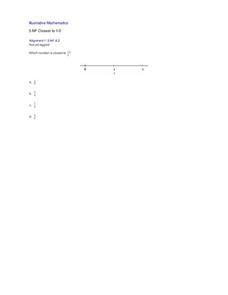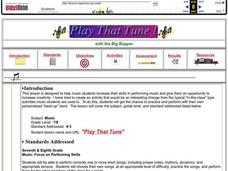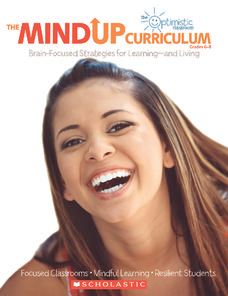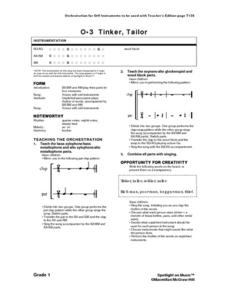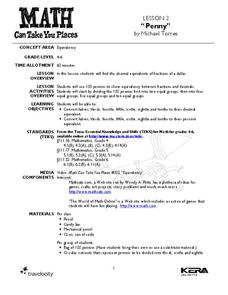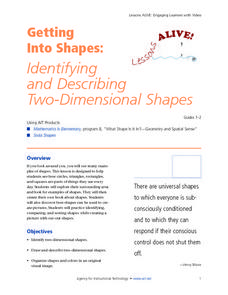Curated OER
Closest to 1/2
Using a number line, pupils are asked to identify which of four fractions is closest to one half. Includes a single problem that can serve as a practice problem or formative assessment for 3rd or 4th graders learning to partition number...
Curated OER
Elements of Art Review--SMART Board Jeopardy
Eighth graders focus on the elements of art with a secondary focus on the principles of art. They are assigned to a team to play Art Jeopardy. They take an exam. They use the internet as a resource for answers.
California Mathematics Project
Reflections
Reflections are the geometric mirror. Pupils explore this concept as they discover the properties of reflections. They focus on the coordinates of the reflections and look for patterns. This is the third instructional activity in a...
Curated OER
Name That Tune
Integrating technology and music can be a snap with lessons like this one! Kids in a junior high band class took to the Internet to download and practice playing their instrument with a computer generated back up band. They practice...
Scholastic
Mindful Listening
Teach your middle schoolers to use their ears to their highest potential! Pupils practice active listening skills and reflect on how careful listening might prove to be important in and out of the classroom.
Delegation of the European Union to the United States
The Single Market and Free Trade
What are the benefits of a single EU market? Class members conclude their examination of the European Union by focusing on the single market concept designed to bring down barriers, create more jobs, and increase prosperity.
EngageNY
Nonlinear Models in a Data Context
How well does your garden grow? Model the growth of dahlias with nonlinear functions. In the lesson, scholars build on their understanding of mathematical models with nonlinear models. They look at dahlias growing in compost and...
PBS
Inspector Detector
How do spacecraft detect magnetic fields? The fourth installment of a five-part unit has learners develop a device with magnets that allows for the detection of magnetic fields. They use a map of an imaginary planet to try out their...
EngageNY
Truncated Cones
Learners examine objects and find their volumes using geometric formulas in the 21st installment of this 25-part module. Objects take the shape of truncated cones and pyramids, and individuals apply concepts of similar triangles to find...
EngageNY
Problem Solving When the Percent Changes
Use more than one whole to solve percent problems. The ninth installment in a 20-part series has pupils work percent problems in which they must determine two wholes. Individuals use double number lines to represent and solve the...
Curated OER
Totally Ternary
First graders compose a simple nursery rhyme with percussion and instrumental accompaniment in the general music classroom setting. AB form and rhythmic patterns are emphasized in this 35-40 minute lesson plan.
Curated OER
Vitamin A
Students explore non-locomotor movements and instrument improvisation creating accompaniments to the song "Vitamin A" in this elementary-level General Music lesson. The lesson nutrition messages links and student challenges for advanced...
Curated OER
Composing Project
Students design, compose, and present short musical compositions for keyboard in this lesson plan meant for the high school choir class. This lesson can be adapted to any time frame, but the author suggests a considerable amount of time...
Curated OER
My Way
Students culminate a humanities project by improvising music to accompany a video of a particular era in US history.
Curated OER
Broccoli
Students compose, notate, and evaluate their own rhythmic compositions using the song "Broccoli" for inspiration in this excellent elementary-level General Music lesson. Emphasis is placed upon four-measure patterns and the classic...
Curated OER
Tinker, Tailor
First graders practice the song "Tinker, Tailor" using percussion instruments, Orff instruments, and their voices in this Music lesson for the 1st grade. The lesson is intended for use within an Orff unit of study and includes...
Curated OER
Chinese Percussion Music
Students investigate Chinese percussion instruments and ensemble performances. They play compositions with Chinese percussion instruments such as small gongs, large gongs and drums.
Curated OER
Penny
Students explore the concept of equivalency. In this equivalents lesson, students use pennies to show equivalency as they divide them into groups. Students also convert the pencils into decimals and fractions.
North Carolina Standard Curriculum
Rhythm Counting
Understanding time signatures and rhythm counting are two very important parts of playing an instrument well. Here are three basic lessons rolled into one that prompt upper graders to play their instruments with care. They'll practice...
Curated OER
How to Read a Ruler
A n incredibly thorough worksheet on how to read and use a ruler awaits yours learners. Students identify lines on the ruler and use the proper abbreviations for the lengths. Learners answer ten questions about ruler usage.
Curated OER
Simple Machines
Eighth graders work together in groups to introduce themselves to the six types of simple machines. They are to record what the machine does, its mechanical advantage and identify real world situations in which they are used. They...
Curated OER
Area Of A Circle
Students investigate the concept of area and how it can be applied to a circle. They use the right formula in order to solve different problems. The teacher leads the class through different examples and serves as a resource during...
Curated OER
Slavery: Population Growth in Arkansas
Eighth graders examine the number of slaves in Arkansas in each census period from 1820 to 1860. They graph the data using the proper labeling and write a paragraph summarizing the data from each period making comparisons between slave...
Curated OER
Getting Into Shapes: Identifying and Describing Two-Dimensional Shapes
Young scholars examine their classroom to find examples of various types of shapes. After identifying and describing the various shapes, they draw as many as they can on a piece of paper. They organize them into an image based on their...


